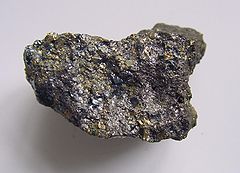- Digenite
-
Digenite 
Digenite from the East Colusa Mine, Butte, Montana, USA. Specimen size = 4.3 cmGeneral Category Sulfide mineral Chemical formula Cu9S5 Strunz classification 02.BA.05e Dana classification 02.04.07.03 Identification Molar mass 146.45 g Color Blue to black Crystal habit Pseudocubic crystals are rare, usually as intergrowths with other copper sulfides Crystal system Trigonal Hexagonal scalenohedral H-M Symbol (32/m) Space Group: R3m Cleavage {111} (observed in synthetic material) Fracture Conchoidal Tenacity Brittle Mohs scale hardness 2.5 to 3 Luster Submetallic to metallic Streak Black Diaphaneity Opaque Specific gravity 5.5 to 5.7 observed, 5.628 calculated Optical properties Reflectivity: 21.6 at 540 nm Other characteristics Distinctly blue in polished sections References [1][2][3][4] Digenite is a copper sulfide mineral with formula: Cu9S5. Digenite is a black to dark blue opaque mineral that crystallizes with a trigonal - hexagonal scalenohedral structure. In habit it is usually massive, but does often show pseudo-cubic forms. It has poor to indistinct cleavage and a brittle fracture. It has a Mohs hardness of 2.5 to 3 and a specific gravity of 5.6. It is found in copper sulfide deposits of both primary and supergene occurrences. It is typically associated with and often intergrown with chalcocite, covellite, djurleite, bornite, chalcopyrite and pyrite. The type locality is Sangerhausen, Thuringia, Germany, in copper slate deposits.[1]
Occurrence
Digenite occurs in the transitional zone of supergene oxidation of primary sulfide ore deposits, at the interface between the upper and lower saprolite ore zones. It is rarely an important mineral for copper ores, as it is more usually replaced by chalcocite further up in the weathering profile, and is a minor weathering product of primary chalcopyrite. Natural digenite always contains a small amount of iron and is considered to be stable only in the Cu-Fe-S system.[5]
In the Deflector and Deflector West Cu-Au lode deposits of the Gullewa Greenstone Belt, Western Australia, digenite is an important constituent of the transitional Cu-Au ore. However, it is difficult to treat metallurgically and remains a refractory ore type. In this locality digenite is found with covellite, chalcocite and bornite.
It was first described in 1844 from the type locality of Sangerhausen, Saxony-Anhalt, Germany. The name is from the Greek digenus meaning of two origins in reference to its close resemblance with chalcocite and covellite.[1]
Polymorphs of Digenite
There are three polymorphs of digenite, high, metastable and low.[6] There is a complete solid solution series between high digenite and berzelianite Cu2-xSe (x~0.12).[7]
High digenite is stable above 73 °C, with space group Fm3m and unit cell parameters a=5.57 Å and Z=1 for formula Cu7.2-xS4. High digenite is isostructural with bornite Cu5FeS4.[6]
Metastable digenite forms on cooling from 73 °C. It appears to be isometric with space group Fd3m and a=27.85 Å. This symmetry, however, is due to twinning of fine domains with rhombohedral symmetry, trigonal -3m, point group R-3m,[6] a = 3.92 Å, c = 48 Å, Z =15 for formula Cu1.8S.[1] Metastable digenite changes with time to stable low temperature digenite[6] or a mixture of anilite Cu7S4 and djurleite Cu31S16.[5]
Low digenite is isometric, space group Fd3m and a=27.85 Å, ie the same as the apparent isometric symmetry of the metastable polymorph,[6] Z=4 for formula Cu1.8S.
References
- ^ a b c d http://www.mindat.org/min-1291.htm
- ^ Gaines et al (1997) Dana's New Mineralogy Eighth Edition, Wiley
- ^ http://rruff.geo.arizona.edu/doclib/hom/digenite.pdf Handbook of Mineralogy
- ^ http://webmineral.com/data/Digenite.shtml Webmineral data
- ^ a b American Mineralogist (1970) 55:106
- ^ a b c d e American Mineralogist (1963) 48:110
- ^ Canadian Mineralogist (2008) 46: 219-231
- Palache, C., H. Berman, and C. Frondel (1944) Dana’s system of mineralogy, (7th edition), v. I, pp. 180–182.
Categories:- Sulfide minerals
- Copper minerals
Wikimedia Foundation. 2010.
